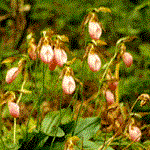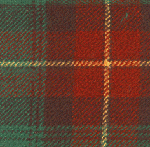

The Flag
of Prince Edward Island
 The Island flag
is rectangular in shape bordered on three sides away from the
mast by alternative bands of red and white. The flag contains the
coat of arms which was created in 1769 when the Island of St.
John (known today as Prince Edward Island) was made a separate
colony and required a government seal. History records that His
Majesty, King George III, expressed his desire for the seal to
have a large oak tree to represent the Mother Country; and, in
the shadow of that magnificent oak there would be a small oak
with a corrugation of three representing the Island and its three
counties: Kings, Queens and Prince.
The Island flag
is rectangular in shape bordered on three sides away from the
mast by alternative bands of red and white. The flag contains the
coat of arms which was created in 1769 when the Island of St.
John (known today as Prince Edward Island) was made a separate
colony and required a government seal. History records that His
Majesty, King George III, expressed his desire for the seal to
have a large oak tree to represent the Mother Country; and, in
the shadow of that magnificent oak there would be a small oak
with a corrugation of three representing the Island and its three
counties: Kings, Queens and Prince.
Although not on the flag, the proper coat of arms appears with
the words “PARVA SUB INGENTI,” which literally
translates as: “Little under the great.” In other
words, England promised to protect her little colony as the great
oak protects the little oak from harm.
The Floral Emblem of
Prince Edward Island
 On April 25, 1947, the Legislative
Assembly dedicated the lady’s-slipper (Cypripedium
acaule) as the floral emblem of Prince Edward Island. As a
species of orchid, the lady’s-slipper gained its name from
the shape of its petals which form a pouch somewhat like a
slipper. The flower is pollinated by bees that tumble into the
pouch and, while escaping, the bees brush against the male and
female flower parts. The lady’s-slipper thrives in shady and
moist woodlands and it blooms in late May and June.
On April 25, 1947, the Legislative
Assembly dedicated the lady’s-slipper (Cypripedium
acaule) as the floral emblem of Prince Edward Island. As a
species of orchid, the lady’s-slipper gained its name from
the shape of its petals which form a pouch somewhat like a
slipper. The flower is pollinated by bees that tumble into the
pouch and, while escaping, the bees brush against the male and
female flower parts. The lady’s-slipper thrives in shady and
moist woodlands and it blooms in late May and June.
The Provincial Bird—Blue Jay
 A public vote in
correspondence with Environment Week in 1976, led to the official
declaration of the blue Jay as Prince Edward Island’s avian
emblem during the 1977 session of the Provincial Legislature. The
blue jay is adorned with a sky-blue hood, wings and tail
feathers; a white throat and breast; and black arcs across the
wing tips. This provincial bird is common across the Island and
is generally considered non-migratory. The blue jay has a varied
diet consisting of grains, animal matter, seeds and suet.
A public vote in
correspondence with Environment Week in 1976, led to the official
declaration of the blue Jay as Prince Edward Island’s avian
emblem during the 1977 session of the Provincial Legislature. The
blue jay is adorned with a sky-blue hood, wings and tail
feathers; a white throat and breast; and black arcs across the
wing tips. This provincial bird is common across the Island and
is generally considered non-migratory. The blue jay has a varied
diet consisting of grains, animal matter, seeds and suet.
The Tartan
of Prince Edward Island
 Following a province-wide
contest in June of 1960, a tartan designed by Mrs. Jean (MacLean)
Reed, a native of Souris, was adopted as the official Island
Tartan. The reddish-brown epitomizes the redness of the soil, the
green characterizes the grass and trees, the white represents the
caps on the waves, and the yellow depicts the sun.
Following a province-wide
contest in June of 1960, a tartan designed by Mrs. Jean (MacLean)
Reed, a native of Souris, was adopted as the official Island
Tartan. The reddish-brown epitomizes the redness of the soil, the
green characterizes the grass and trees, the white represents the
caps on the waves, and the yellow depicts the sun.
The
Provincial Tree—Red Oak
The Prince Edward Island Legislature proclaimed
the northern red oak (Quercus rubra) as our Island tree
in May of 1987. The Island Government’s intent was to
recognize the economical and historical importance of the forests
to our province. Historically, the red oak had been used in the
ship building trade and also for making barrels for the transport
of dry goods. Today, the red oak is used for the building of
furniture, interior finishing and flooring. Occasionally you may
find pure stands of red oak. However, it is most often found
nestled among other common species of trees such as birch, pine
and maple. The tree appears on both the Island flag and coat of
arms.
The Provincial Soil—The Charlottetown Series
Provincial Soil—The Charlottetown Series
Ten years after the red oak was proclaimed the
provincial tree, the Charlottetown soil series was designated as
the official soil of Prince Edward Island. On February 21, 1997,
the Island’s Agriculture and Forestry minister, Eric
Hammill, adopted the Charlottetown soil series as an Island
emblem to recognize Prince Edward Island’s greatest natural
resource—the land. The Charlottetown series is the most
predominent soil type on the Island and it accounts for almost
one third of our total acreage. The soil has a moderately
well-drained sandy loam texture and is somewhat stone free. It is
considered the best soil for the production of one of the
Island’s most famous commodities—the potato.